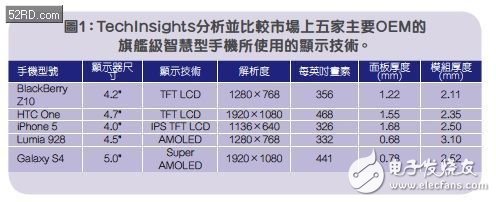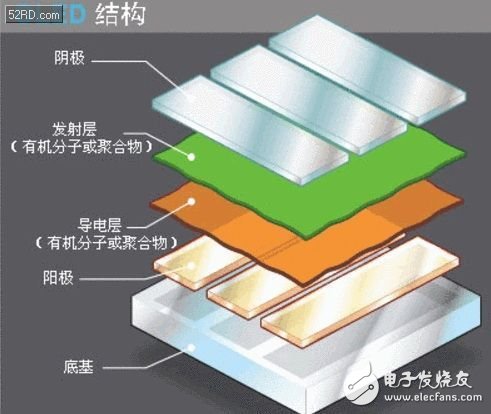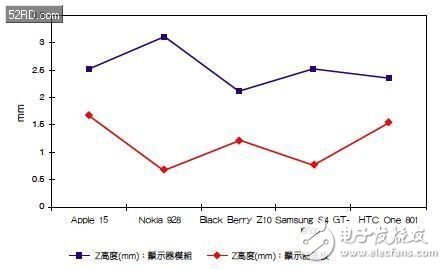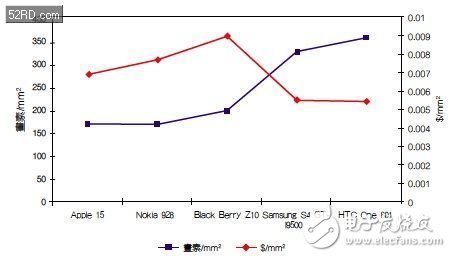According to the consumer's purchase behavior, the visual impression and function of the smartphone have an important impact on the consumer's purchase decision. In order to succeed in the highly competitive smartphone market, mobile phone manufacturers have invested heavily in display design and technology.
The constant integration of more and more features in smartphones gives designers the pressure to find ways to use available space more efficiently. The largest electronic component displays and touch screens that often appear on mobile phones or tablets have become the goal of designers working to reduce overall device thickness while improving display quality.
To gain insight into smartphone design choices and trade-offs, TechInsights analyzed the display technologies used in the flagship smartphones of five major OEMs on the market.

TechInsights analyzes and compares the display technologies used by the flagship smartphones of the five major OEMs on the market.
Unsurprisingly, TechInsights found that these phones include the three most common display technologies on the market today:
Thin film transistor liquid crystal display (TFT LCD)
Planar Conversion LCD (IPS LCD) Retina Display (and LCD with Higher Pixel Density)
Active Matrix Organic Light Emitting Diode (AMOLED) display
The TechInsights dismantling team compared power consumption, display thickness, and pixel density and cost to confirm the relationship between form factor and cost achieved by different system manufacturers. Finally, it was found that the price of the display is not very flexible, and at the same time, a larger size or a higher pixel density does not necessarily mean a higher procurement cost.
It is generally believed that LCD displays consume more power than AMOLED displays because LCDs use more power and thus affect battery life. The satisfaction of many users is still based on the quality of the display and the time of use after charging. The shorter battery life of an LCD is usually due to the use of 8 to 12 LCD-backlit LEDs that are continuously turned on at all levels of brightness. In contrast, about one million LEDs in an AMOLED display are only conductive when in use (also at various levels of brightness). While typical AMOLED displays do consume less power, it should be noted that when the display is very bright and mostly white, the actual power consumed is greater.
The reason why Samsung chose AMOLED may also be due to its durability and improved video and photo rendering performance. In particular, Samsung's PenTIle technology is also based on AMOLED, which is widely used in many of its flagship devices.

Is the thickness of the display inversely related to the thickness of the module?
One might think that the thinnest display should be able to design the thinnest display module. This module contains the peripheral structures and components that are used to integrate the display into the phone. However, the TechInsights dismantling team found in the dismantling of several high-end mobile phone samples that the thickness of the display is almost inversely related to the thickness of the module.
In addition, if new display performance (such as pen support) and improved features (faster refresh rate, lower power consumption) are used, the thickness of the display module will increase.

Z height comparison
Relationship between pixel density and cost
Similarly, one might think that the most expensive display module should provide the highest display resolution. Surprisingly, however, this is not the case.
After comparing the technology types (resolution), Z height and cost of the five smartphones, TechInsights found an interesting result. By plotting the resolution (pixel density) versus cost, and then comparing the Z height, it was found that three of the vendors paid a much higher cost of about 45% for the pixel/mm2 index, which was reduced by about 45%.

Pixel density/cost comparison.
This unexpected resolution/cost result is very interesting, but how can this interesting compromise be explained?
TechInsights speculated that because pixel density has reached a certain level, pixel density is no longer a competitive differentiation factor from the perspective of end users. Therefore, more considerations are in the durability and functionality of the display, maintaining durability and improving battery life through lower power consumption, thereby providing a better experience for the user. Taking Samsung as an example, its focus on developing AMOLED power with lower pixel density comes from emphasizing better power management to provide longer usage time and better user experience.
A new display technology, Indium Gallium Zinc Oxide (IGZO), has recently appeared on the market, but it has not been used in any of these phones. The technology was first used in Sharp's Aquos Zeta phone.
The new display technology, jointly developed by Sharp and the Semiconductor Energy Lab (SEL), offers the potential to deliver higher resolution, faster display refresh rates, lower power consumption and softer displays. TechInsights believes that modules using this technology will be larger than AMOLEDs, and the initial cost of integration into mobile phones may be higher. However, in the fast-growing wearable electronics market and in devices designed to take advantage of more durable designs, the flexibility of such display screens (and systems using this technology) is expected to yield higher profits.
The smartphone display market continues to drive technology forward, giving us more power, better visibility and lower power consumption. Based on the analysis of these five smartphones, TechInsights evaluated how different system manufacturers can use current technology to reduce costs, optimize power consumption, and create interactive displays that fit more functions to differentiate devices.
In addition, there is no consistent trend in the Z height or final product cost of the display. This huge change has led us to believe that while handset manufacturers are undoubtedly more concerned with cost issues, they can still find more space to reduce costs while continuing to provide a rugged user experience.
- 20A 120VAC Two Tamper-Resistant (TR) receptacle enhance electrical safety, preventing objects from being inserted into the outlet
- The USB Ports are Class 2.0 and feature a combined power of 5Vdc,3.1 Amps
- Terminal screws accept up to 10AWG copper or copper clad wire
- The USB charge receptacle is to be installed in a wall box measuring at least 3"X2"X2-1/2", and wired in accordance with NEC acticle 314 box fill requirements
-
UL & CUL listed
- With a wall plate
4A USB TR UL,High Speed 4A USB TR UL,Universal 4A USB TR UL,Electrical 4A USB TR UL
Hoojet Electric Appliance Co.,Ltd , https://www.hoojetgfci.com